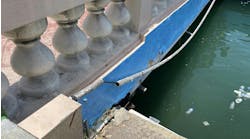How well do you know the Code? Think you can spot violations the original installer either ignored or couldn't identify? Here's your chance to moonlight as an electrical inspector and second-guess someone else's work from the safety of your living room or office. Joe Tedesco, who has a knack for finding shoddy electrical work, did the dirty work and found this mess. Now it's your turn to identify the violation.
Find the Answer
The following individuals correctly identified the Code violations shown in the August column: Leon Sokhis, electrical engineer, Solar Turbines, Inc., San Diego; Richard Sullivan, junior engineer, Kinsman & Associates, Richardson, Texas; and John Reichardt, electrical designer, Vanderweil Engineers, Alexandria, Va. This extension cord can't be used in any Class I, Division 1 or 2 hazardous (classified) location. Although 501.4(D)(2) permits flexible connections at motor terminals, only flexible explosionproof type fittings that are listed for Class I, Division 1 hazardous (classified) locations, or flexible cord in accordance with the provisions of 501.11 are permitted. These rules don't cover extension cords. See the definition for “Explosionproof Apparatus” in Art. 100 and 500.2 for specific guidance related to electrical equipment installed in hazardous locations.
The installation also violates the requirements of 501.13, which states, “Where condensed vapors or liquids may collect on, or come in contact with, the insulation on conductors, such insulation shall be of a type identified for use under such conditions; or the insulation shall be protected by a sheath of lead or by other approved means.”



